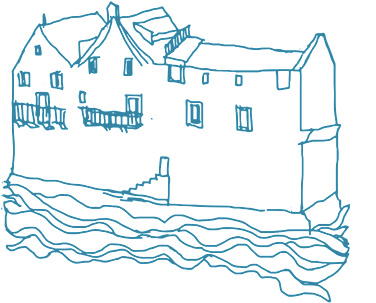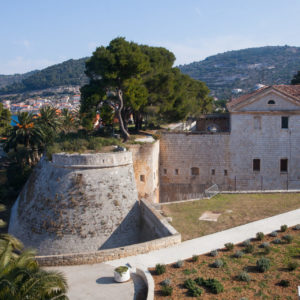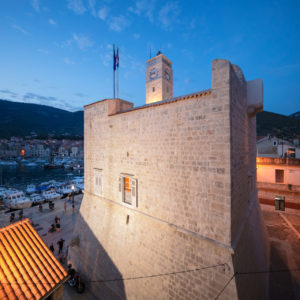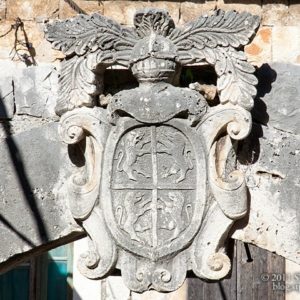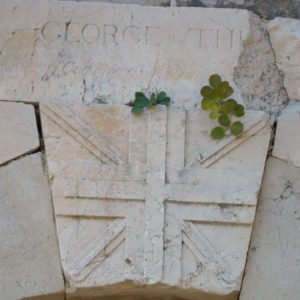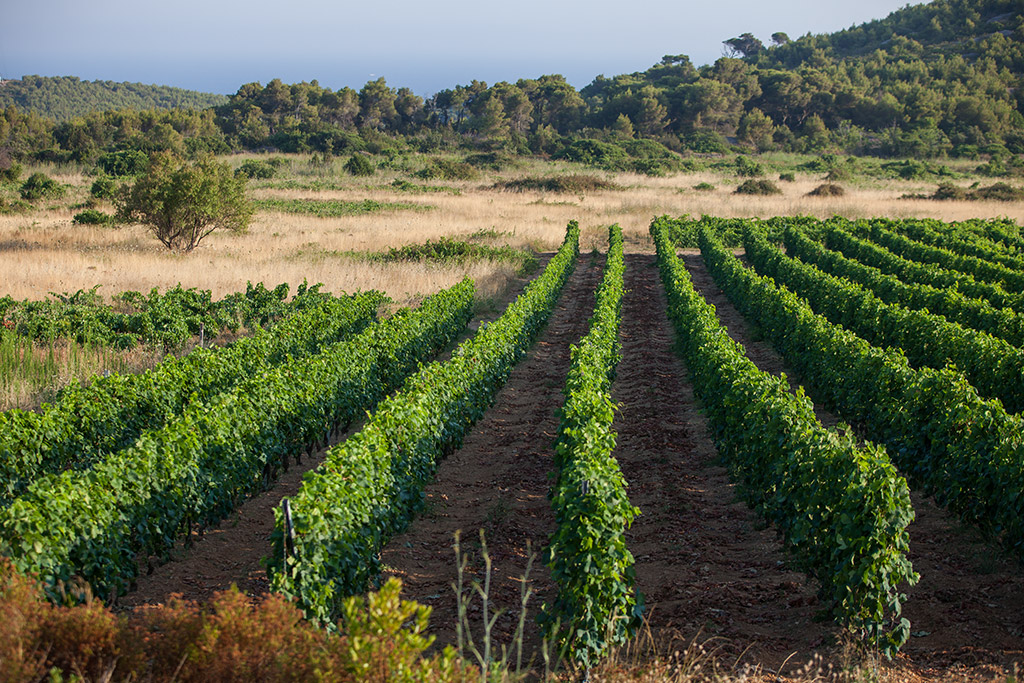Throughout history, due to its strategic position in navigation along the Adriatic, the island of Vis and its archipelago has been – a fortress. The insecurity caused by pirates and Turkish attacks since the 16th century has forced the inhabitants to build towers and smaller forts, many of which have been preserved to the present day, to name a few:
Fortress ‘Komuna’ in Komiža
Due to the frequent attacks of Turks and pirates on Komiža, a fort was built in 1595, during the time of Prince Ivan Grimani of Hvar, whose coat of arms and cross were carved on the inscription above the entrance. The Venetian administration was reluctant to finance the construction of the fortresses in their entirety, so the construction slowed down. Fishermen from Komiža came to the rescue, as evidenced by an inscription from 1592. on the north wall of the fortress: this building is the work of a ‘Trešjavac position’. It is a fishing position south of the island of Biševo, where fishermen from Komiža have been working hard to raise money to complete their fort.
At the beginning of the 19th century, the fort was held by a smaller English military crew. In 1870, a tower with a bell dating from 1722, was erected above one corner of the fort. Nine years later in 1879. the municipality of Komiža bought the fort and located its offices there – hence its name Komuna (Commune). At that time, on the fort the windows were opened and the balconies were built, also the clock tower with the bell was added to the exhisting turret.
The fortress is actually a spacious tower with a regular square base with sloping lower walls. At the top of the fort is a terrace with a wide crown. At the time of construction, the fortress was partly in the sea, and on the north and west walls, are still present, well preserved, the solid stone rings for the mooring of ships.
Nowadays, the fortress Komuna hosts a unique Fisherman’s Museum.
Location: The fort Komuna (Commune) dominates the port of Komiža.
Bataria (Batarija) – Vis
Bataria Fortress or Our Lady’s Fortress, was the main fortress of the town of Vis. It was built in the middle of Vis harbour, in 1830, by the Austrian administration. This fort played a significant role during the famous Battle of Vis, in 1866, when Italian ships penetrated the harbour, and attempted to land on the island, but were driven off by a cannon fire from Bataria, which was almost the only one of the surplus forts capable of operating and maintaining artillery fire.
It was surrounded by a moat, and had a heavily fortified barracks with loopholes and a bulging center section in the middle of the south wall. In front of the fortress there is a courtyard with wells, and ahead of it there is a high embankment surrounded by a sloping wall, with warehouses and dungeons inside. The entrance is located on the southern part of the fort, leading you into a spacious courtyard with water tanks. The back of the fort is occupied by an army barracks, later converted into an almshouse and a hospital, so its windows were widened and the embankments were afforested. Today, it houses Archaeological Museum rich in exhibits, while during the summer in its courtyard there are concerts, performances and various events.
Location: From the port of Vis, you can get to the fortress Batarija in 15 minutes, easy walking.
Fort Wellington
Located at the eastern entrance to the port of Vis, built in the early 19th century, during the British rule. It was built on St. George’s Hill (Jurjevo brdo), named after the church of Sv. George (sv.Juraj). The fortress is named Wellington after the field marshal Arthur Welleseley, 1st Duke of Wellington, the victor over Napoleon at the Battle of Waterloo in 1815.
Because of the name itself, it is assumed that it was completed closely after that famous victory, that is in the last days of the English stay on the island. On its round walls can be seen the loopholes, and the interior is secured by two transverse walls, between which is a circular pedestal with demolished arches walled up by bricks.
Location: Wellington Fort is 5 kilometers from Vis.
King George III Fort – Fortica – Vis
On the list of the most beautiful locations on the Adriatic coast, there is the mysterious citadel Fort George. Just a glance at this historic building, which today is the pinnacle of tourism, is breathtaking. On the hill above the town of Vis, it stands as a monument of the beauty of architecture of that time and adorns the entrance to the bay itself. Fort George was built by the English commander of Vis, George Duncan Robertson in 1812, and was named after the British King George III.
The entire fort, which is today comonly called “Fortica” by the locals, is surrounded by a moat and has the sloping walls. The entrance to Fortica is magnificent, over a suspension bridge through a wide wooden door, with an English flag engraved in the middle of the arch (above). Inside the fort, there are two courtyards surrounded by ditches – with a well in the northern yard . On the terrace of the inner fort there are semicircular cannon holes, and all the walls are secured by loopholes.
For two centuries, this fortress served for military purposes, before being abandoned. In 2013 it is restored as a tourist and catering facility.
During the summer days, parties, concerts and various entertainments are organized to encourage residents and tourists to visit the fort. The fort also has a small museum where you can see interesting exhibits – maps, charts and various other items concerning the exciting history of Fortica.
Due to the incredible view from the rooftop terrace to the port of Vis and the neighboring islands, the beautiful garden and the surrounding environment, many couples have decided to say fateful ‘I do’, right here, in one of the currently most romantic locations in Croatia.
The fort is hidden behind the pine and cypress trees, which in the summer create a pleasant shade and a romantic setting. Once you reach it, it will surely tickle your imagination to peek inside its walls. It should be acknowledged that the place of the most beautiful sunrise and sunset on the island of Vis is on Fortica.
Location: This historic building has become one of the magnificent locations you should/must not bypass. It is easiest to reach by car, but the locals prefer to take a twenty-minute walk, enjoying a fantastic view of the town of Vis. From the port of Vis to Fortica, you need 5 minutes by car.
Fortified church of st. Roch (sv. Rok) – Komiza
On the Adriatic islands, exposed to pirate attacks,there were fortified churches and monasteries. One such church – a fortress, is located at the entrance to Komiža, on the coastal part of the town. It was built in 1763 by the family Mardešić, from Komiža. The previous church that was built in the 16th century, at the time of the plague, was converted into a sacristy, and a new one was built next to it, the church – fortress of St. Rocco.
Even today there are no windows on the walls of the church, except the round one on the front and the window under the roof, as well as the side loopholes and the hanging defensive wall on consoles built above them.
In the 20th century, a small bell tower was erected, which along with the altar was relocated from the old church, i.e. from the sacristy. Inside the church there is a late Baroque altar with a painting by the Italian artist from the 19th Century – Our Lady of Carmel, St. Roch, St. Vincent Ferrer and St. Simon Stock.
Today, in the church, the Holy Mass is celebrated on the day of the patron saint of the church (August 16), and on the day of Our Lady of Mount Carmel (July 16).
Location: From the port of Komiža to the Church of St. Roch takes some 7 – 8 minutes, easy walking.
Fortress Hoste
At the entrance to the port of Vis, there is the islet Host, which is only 120 meters long and 36 meters wide. The old popular name for this islet was Sveti Juraj (Saint George), but during the British rule on the island, it was renamed into Host.
In 1811 Sir William Hoste, a young captain and commander of the British Navy in the Adriatic, erected an artillery fort on this island that was part of the defence system on the Fortica (Fort George III) – Wellington line, which, at that time, protected the port of Vis from the sudden attack of the French and Russians.
Hoste was a favorite of Vice-Admiral Lord Nelson, and was sent to the Adriatic with only four ships. In just two months, in 1810, Hoste captured or sunk 40 ships. On March 13, 1811, a French – Italian fleet of 11 ships under the command of Bernard Dubourdieu attacked him near Vis. This did not terrify the young Host, he destroyed and captured four ships, and killed Dubourdie during the battle. This and the other victories, brought immense popularity to the young British officer.
In ancient times there was a quarantine on this island. In order to protect the local population, all passengers from ships arriving to Vis had to spend some time in quarantine to determine whether they were infected with any of the diseases of the time, plague or cholera.
On the site of the former Fortress Host, in 1873, a lighthouse was built, and in the following decades the lighthouse keepers and their families constantly lived there. Being those the times under the rule of Austro-Hungary, the families were of various nationalities: Germans, Hungarians, Czechs, Poles, but the longest serving lighthouse-keeping family was, almost inheritably, a family Siminiati from.
Host is currently on the list of only eight islands from all over the world, which is recommended the newlyweds for the ideal honeymoon. Just a five-minute boat ride away from the town of Vis, this piece of land for two has been transformed into an oasis in which complete privacy is guaranteed. The lighthouse has been converted into a comfortable accommodation with two double bedrooms, a kitchen, and a living room. Below the building there is a small beach, and a special attraction – a stone terrace for memorable breakfasts and sunsets to remember.
Location: The Isle of Host is located just 500 m from the coast, 5 minutes taxi ride.
